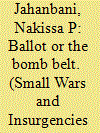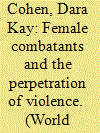| Srl | Item |
| 1 |
ID:
168220


|
|
|
|
|
| Summary/Abstract |
In recent years, an upward trend in terrorist attacks has mirrored an increase in suicide attacks. According to our preliminary analysis, the events of September 11th marked a sea change in the number of terrorist attacks. While a rich literature has evaluated why terrorists participate in suicide attacks, none have considered the uptick in volume after 9/11, and fewer yet have considered how female fighters may be contributing to this. We evaluate how both structural and female-specific factors affect the likelihood of female fighter suicide attacks. Recent literature discovered a trend in terrorist groups using females as suicide bombers due to cultural norms that permit them to get closer to targets. We test our theory using data from the Chicago Project on Security and Threats Suicide Attack Database (CPOST-SAD) and various datasets from the Quality of Government (QOG) compendium for the 1986–2016 time period. We construct a series of models that consider both female-specific and structural factors that could explain variation in the number of female suicide attacks. Our results indicate that our models encompass relatively stable patterns. Female political empowerment, female educational attainment, and female employment rates are significant and positive in our post-9/11 models, indicating that they may increase female suicide attacks. Democracy is a relevant structural factor and generally yields a positive effect on female suicide attacks across both time periods and multiple models. Ethnic fractionalization is significant in both time periods but yields a negative effect before 9/11 and a positive effect in the later period.
|
|
|
|
|
|
|
|
|
|
|
|
|
|
|
|
| 2 |
ID:
121906


|
|
|
|
|
| Publication |
2013.
|
| Summary/Abstract |
Much of the current scholarship on wartime violence, including studies of the combatants themselves, assumes that women are victims and men are perpetrators. However, there is an increasing awareness that women in armed groups may be active fighters who function as more than just cooks, cleaners, and sexual slaves. In this article, the author focuses on the involvement of female fighters in a form of violence that is commonly thought to be perpetrated only by men: the wartime rape of noncombatants. Using original interviews with ex-combatants and newly available survey data, she finds that in the Sierra Leone civil war, female combatants were participants in the widespread conflict-related violence, including gang rape. A growing body of evidence from other conflicts suggests that Sierra Leone is not an anomaly and that women likely engage in conflict-related violence, including sexual violence, more often than is currently believed. Many standard interpretations of wartime rape are undermined by the participation of female perpetrators. To explain the involvement of women in wartime rape, the author argues that women in armed group units face similar pressure to that faced by their male counterparts to participate in gang rape. The study has broad implications for future avenues of research on wartime violence, as well as for policy.
|
|
|
|
|
|
|
|
|
|
|
|
|
|
|
|